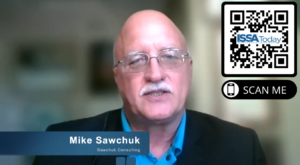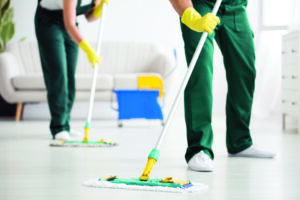This article originally appeared in the July/August issue of ISSA Today
by Mike Sawchuk — Many custodial operations are good at what they do. Some are excellent. But as a facility management (FM) executive or the leader of a cleaning operation, how do you really know where on the scale your operation lies? What data do you use to benchmark your team’s work? How do you confirm that your custodial operation is best-in-class to the various stakeholders? How can you show that you are protecting occupants and are able to justify your budget, your staffing, and your own position?
A deep-dive assessment is the best way to ensure you are protecting the health of facility occupants and the future of your cleaning operation.
The value of data
Data does not lie. Data can be used to develop an improvement plan that produces long-term sustainable changes to ensure your custodial operations consistently deliver the highest clean, safe, and healthy levels at the lowest overall cost.
Assessments build knowledge. They build confidence. Assessments are based on data, which verifies results. As former President Ronald Reagan said, “Trust but verify.”
With this in mind, let’s look at the major components of a cleaning operation assessment.
Manage expectations
How can you meet — let alone exceed — expectations if you don’t know what those expectations are? Sometimes this step is ignored because FMs believe they already know what is expected of them and their teams. However, assessments are based on facts, not guesses. You may, for example, be surprised to discover that some things you thought were important are less so, and areas you gave little attention to are critical to specific stakeholders.
For an assessment to be useful, you need to have clear, detailed expectations from all stakeholders. This information allows you to lead your team and ensure expectations are met. Put the expectations in writing to prevent miscommunications and implement a process for periodic checks and updating.
Focus on results
An assessment needs to measure, collect, track, and report results. For example, you may have to change the methodology to update old processes or ineffective procedures. However, you can’t know what may require changing unless you know precisely how you are doing. Results tell you what is working and where improvements may be needed.
Collecting cleaning results
Cleaning results can be measured in many ways, including those below.
- Visual/smell with a checklist. Walking around inspecting areas and surfaces to determine if the areas look and smell clean. While this is a good first step, it is not recommended as the only one because: (1) If the Covid-19 pandemic has taught us anything, it’s that surfaces can look and smell “clean” and still carry potentially dangerous pathogens; (2) it is subjective — what appears clean to one supervisor may not to another; (3) you have no data to prove your surface is as clean and/or disinfected as you say it is.
- Florescent gel and black light. This can be used with the visual/smell test. The gel, invisible to the naked eye and easily removed during cleaning, is placed on random surfaces. After cleaning is completed, an ultraviolet (UV) light is used to see if the gel was removed, indicating whether the surface was cleaned or not. While this is often good for training purposes, it does not provide irrefutable data.
- ATP meters. These meters test for adenosine triphosphate (ATP). This is currently the most often recommended way to measure cleaning efficacy. This form of testing consists of swabbing random surfaces after cleaning and using an ATP meter to determine the level of ATP remaining on the surface. ATP is a substance found in all living cells and, therefore, provides a good indication of bacteria and other live pathogens on a surface. However, it should be noted that it does not detect viruses because viruses are not living and, therefore, do not contain ATP.
- Imaging technology. These technologies are relatively new for use in the cleaning industry. Surface imaging produces high-quality images that show where contamination exists.1 It can be used before and after cleaning to demonstrate the difference or just after cleaning to show that the area is clean. Another recent technology in this category is automatic biological contamination detection (AutoDet). This relies on hyperspectral imaging. While typical cameras record the red, blue, and green visible to the human eye, hyperspectral imaging2 enables the recording of hundreds or thousands of colors. Then artificial intelligence is used to help identify and separate living organisms in the camera footage.
Regardless of the method used, recording, tracking, and analyzing the data are essential to ensure targeted results are being achieved. If the results are falling short, the steps necessary to drive improvement (training, retraining, coaching, etc.) must be determined and implemented as soon as possible.

Bonus content! Learn more about how to use evidence-based data in your cleaning operation: issa.com/assessment.
Slips, trips, and falls
Floors are another key custodial area where results should be measured. The monitoring is done to prevent slips, trips, and falls (STF) and the injuries and costs associated with them, including potential worker’s compensation, fines, and lawsuits. An integrated and comprehensive STF program should be developed, and an assessment conducted regularly. The program should include ensuring floors have a safe slip coefficient. Tracking results include recording the dynamic coefficient of friction (DCOF) of products used and completing written reports should any STF incidents occur.
Indoor air quality
Given today’s recognition of the importance of good indoor air quality (IAQ), it is essential to track what is being done to ensure clean air in your facility. These measures can include better filtration, increased ventilation, air-cleaning devices, equipment with HEPA filters, and humidity control. Sensors should also be installed to measure such things as air particulate matter and carbon dioxide. Also, track product use aimed at better IAQ, such as products certified by the UL GREENGUARD program.
Overall operations
In-house custodial departments should also conduct an integrated and comprehensive assessment of their overall operations. This should include about 120+* considerations in three key areas:
- Cleaning products, procedures, and protocols.
- Employees — recruiting, hiring, training, development, and retention.
- Leadership — attitudes, traits, skills, culture, team building, etc.
Reporting the results
Once you have achieved the results you want (best-in-class or close) in the above areas, you need to communicate them proactively. Your communications can be verbal, written, PowerPoint — or, best, all three. In whatever format you choose, you should include what is being done, the methodology and products used, the results, and how these results meet the expectations of each of the stakeholders. A deep-dive assessment based on data can keep your facility safe, clean and healthy.
Mike Sawchuk of Sawchuk Consulting assists building service contractors, in-house facility service providers, manufacturers,and distributors in the professional cleaning industry in improving their outcomes with insightful, pragmatic solutions. He can be reached at 905-932-6501, via LinkedIn, or via his website at sawchukconsulting.com.
Resources:
² https://www.impopen.com/blog/it-clean-hyperspectral-imaging-has-answer

